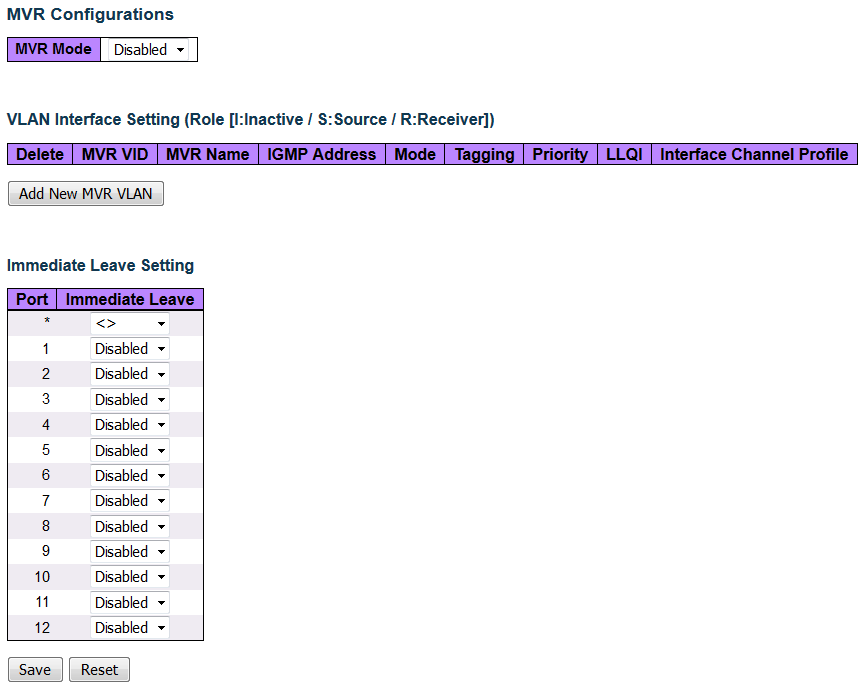MVR
This page provides MVR-related configurations. Most of the settings on this page are global, whereas the Immediate Leave and MVR Port-Role configuration is related to the current selecting stack unit, as reflected by the page header.
The MVR feature enables multicast traffic forwarding on the Multicast VLANs. In a multicast television application, a PC or a network television or a set-top box can receive the multicast stream. Multiple set-top boxes or PCs can be connected to one subscriber port, which is a switch port configured as an MVR receiver port. When a subscriber selects a channel, the set-top box or PC sends an IGMP/MLD report message to Switch A to join the appropriate multicast group address.
Uplink ports that send and receive multicast data to and from the multicast VLAN are called MVR source ports. Up to four MVR VLANs with corresponding channel profile for each Multicast VLAN can be created. The channel profile is defined by the IPMC Profile which provides the filtering conditions.

| Object | Description |
|---|---|
| MVR Mode | Enable/Disable the Global MVR. The Unregistered Flooding control depends on the current configuration in IGMP/MLD Snooping. It is suggested to enable Unregistered Flooding control when the MVR group table is full. |
| Port | The logical port for the settings. |
| Port Role | Configure an MVR port of the designated MVR VLAN as one of the following
roles.
Caution: MVR source ports are not recommended to be overlapped with management
VLAN ports.
Select the port role by clicking the Role symbol to switch the setting. I indicates Inactive; S indicates Source; and R indicates Receiver. The default role is Inactive. |
| Immediate Leave | Enable the fast leave on the port. |

| Object | Description |
|---|---|
| Delete | Check to delete the entry. The designated entry will be deleted during the next save. |
| MVR VID | Specify the Multicast VLAN ID. Caution: MVR source ports are not recommended to be
overlapped with management VLAN ports.
|
| MVR Name | MVR Name is an optional attribute to indicate the name of the specific MVR VLAN. Maximum length of the MVR VLAN Name string is 16. MVR VLAN Name can only contain alphabets or numbers. When the optional MVR VLAN name is given, it should contain at least one alphabet. MVR VLAN name can be edited for the existing MVR VLAN entries or it can be added to the new entries. |
| IGMP Address | Define the IPv4 address as source address used in IP
header for IGMP control frames. The default IGMP address is not set
(0.0.0.0). When the IGMP address is not set, system uses IPv4 management address of the IP interface associated with this VLAN. When the IPv4 management address is not set, system uses the first available IPv4 management address. Otherwise, system uses a pre-defined value. By default, this value will be 192.0.2.1. |
| Mode | Specify the MVR mode of operation. In Dynamic mode, MVR allows dynamic MVR membership reports on source ports. In Compatible mode, MVR membership reports are forbidden on source ports. The default is Dynamic mode. |
| Tagging | Specify whether the traversed IGMP/MLD control frames will be sent as Untagged or Tagged with MVR VID. The default is Tagged. |
| Priority | Specify how the traversed IGMP/MLD control frames will be sent in prioritized manner. The default Priority is 0. |
| LLQI | Define the maximum time to wait for IGMP/MLD report memberships on a receiver port before removing the port from multicast group membership. The value is in units of tenths of a seconds. Range is 0 – 31744. The default LLQI is 5 tenths or one-half second. |
| Interface Channel Profile | When the MVR VLAN is created, select the IPMC Profile as the channel filtering condition for the specific MVR VLAN. Summary about the Interface Channel Profiling (of the MVR VLAN) will be shown by clicking the View button. Profile selected for designated interface channel is not allowed to have overlapped permit group address. |
| Profile Management Button | You can inspect the rules of the designated profile
by clicking |
| Buttons | |
|---|---|
 |
Add a new MVR VLAN. Specify the VID and configure the new entry. |
 |
Save changes. |
 |
Undo any changes and revert to previously saved values. |

